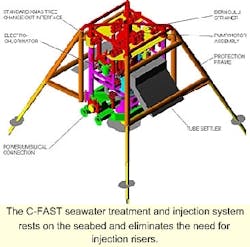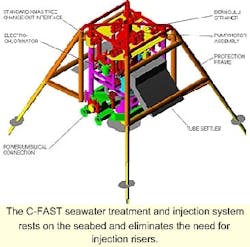A seabed raw water injection system developed by Mentor Subsea Tech nology Services and CAPSIS eliminates the need for topsides seawater treatment facilities, risers, and flowline systems. The system, known as C-FAST (for combined filtration and seawater treatment), is a lower cost option to topsides water injection for reservoir pressure maintenance.
The system represents the culmination of a 10-year program partly funded by the offshore oil and gas industry. During the period, over $3 million has been invested in the development. As part of a joint industry project (JIP), the
C-FAST technology has undergone a rigorous concept-proving program and testing. Delivered water quality meets or exceeds that delivered by conventional means and the performance reliability is high. Operational costs required to maintain the facility throughout its field life are similar to conventional systems.
The system is suitable for both shallow and deepwater developments. The overall system configuration described here is for a deepwater installation, designed for remotely operated vehicle (ROV) inspection, maintenance and repair (IMR). For a shallow water application, the option exists to simplify some of the interfaces for a diver-assist work platform for installation and IMR activities. Some capital expenditures (CAPEX) reductions would result from this diver assist option.
System components
The C-FAST system consists of the following major components:
- Patented tube settler to remove the denser-than-water particles (fine sand)
- Bernoulli cartridge strainer to remove the neutrally buoyant organic matter
- Electro-chlorinator for biological control
- Multistage centrifugal pump and motor
- Control and power supplies configured within a standard API christmas tree guide frame and optional protection structure.
The tube settler is located upstream of the injection pump and was developed specifically for C-FAST. The unit has no moving parts and is a proven separation process utilizing simple glass reinforced plastic construction.
The main objective of the tube settler is the separation of sand and other larger particles at the intake of seawater. The separated products settle out into a contra-flow stream and are dispersed by the prevailing current or by gravity to the seafloor. Well over 99% of the particles greater than 22 microns are removed at this initial stage.
Chlorinator, strainer
Chlorine can be supplied either from the host facility via the control umbilical or from a chlorinator unit, that is integral with the subsea facility. The design of the electro-chlorinator is based on the marinization of a standard topsides unit as an insert cartridge concept.
This is ideal for subsea maintenance and/or replacement. A nominal power input is required to polarize the electrodes and a switching circuit for electrode descaling by polarity reversal.
The Bernoulli strainer is located downstream of the injection pump and limits the ingestion of neutrally buoyant matter greater than 200 microns. This unit is commonly utilized within the fish farming industry for water cleansing and is ideally suited for subsea applications. The design involves only one moving part, the cleaning actuator. The insert cartridge strainer is diver or ROV retrievable.
Injection pump/motor
The pump modular assembly consists of a pump motor cartridge and an electric/hydraulic wet-mateable connection assembly. The assembly is installed into a receiver barrel that forms an integral part of the support structure/protection frame. This configuration allows easy vertical installation and retrieval operations.
The current power requirement of the subsea electrical motors is a maximum of 2MW. This unit can supply two water injection wells with up to 30,000 b/d. The electric motor design is based on a standard range of high voltage (6kV) electric submersible pumps, providing high reliability of both motor and electrical connectors.
Motor internals are protected from over-temperature and ingress of seawater by dielectric oil. It is then maintained at an over-pressure and supplied via the power cable or control umbilical from a barrier fluid (mineral oil) power pack located at the host facility.
Power, speed, data
The control of pump supply pressure and flow can be achieved either by a variable speed drive or by a minimum flow by-pass loop around the pump set. Factors that determine the exact configuration depend on the injection characteristics, distance from the host facility, and motor and power requirements.
Emerging subsea power distribution technologies designed for at least a 5MW-power supply will ultimately be integrated into the overall injection facility architecture as a stand-alone unit.
Control communication and data acquisition will be integrated into a standard water injection control module. The base solution for the control and data acquisition of the C-FAST system is to tie into the multiplexed electro-hydraulic unit used to control the respective water injection trees.
For a given development, the design, function and operation of the subsea control modules (SCM) are dictated by the production well requirements for maximum interchangeability. Given the reduced number of functions to control a water injection tree, spare capacity exists for the additional control elements.
Cost savings
Costs for the injection system depend on the nature of the development scheme, but are potentially much lower than the equivalent topsides facilities. This is principally due to elimination of process risers and flowlines for the water injection process.
A detailed costing analysis has been undertaken on a multi-well development producing back to a floating production facility from two equidistant drilling centers, each 2.2 miles from the vessel, located in 1,640 ft water depth. The water injection facility was based on six wells located at one drilling center, delivering a peak injection rate of 180,000-200,000 b/d at an injection pressure of 3,000 psi.
The analysis demonstrated that a 44% cost savings could be achieved by using a subsea raw water injection system, instead of a conventional topsides water treatment and injection scheme.
Future developments of the C-FAST tech nology are planned that will further reduce the system CAPEX. The following ideas are also being considered for inclusion in the basic design:
- Use of all electric actuators and control systems. With the provision of power to the facility, the all-electric christmas tree should become a reality.
- Once confidence with the concept of raw water injection becomes widely accepted, further relaxation in water quality would reduce equipment inventory required.
- Minimal treated seawater could be used as the control fluid for valve and choke actuators.
- Co-mingling produced separated water with raw water at the seabed helps pressure maintenance.
With the emergence of subsea processing systems, the C-FAST technology can be integrated with other proprietary technologies, such as produced water re-injection.




